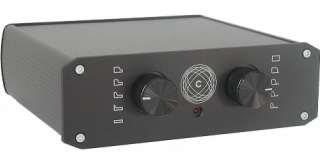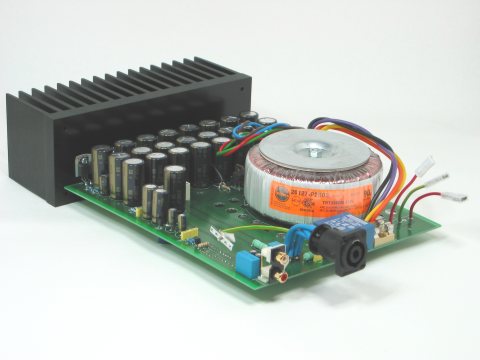|
You are reading the older HTML site Positive Feedback ISSUE 10october/november 2003 Positive Feedback Online Interviews: Dr. Jan Meier of Meier Audio
Jan Meier Read elsewhere for the review of the Meier Audio CORDA HA-2 in this issue. CF: How did you enter audio? JM: As a child I learned to play the piano and have loved music since. Later I studied physics and got a Ph.D. in biomedical engineering at the electronic faculty of a technical university. Living in student housing forced me to use headphones, but the extreme channel separation was a big annoyance to me. Thanks to my technical and biomedical background, I was able to design and build a headphone amplifier with a crossfeed filter that solved this problem. The design of the amplifier was published on Headwize (www.headwize.com), an internet site for headphone lovers. The design soon became very popular, and I started offering DIY kits to help people out. The success of these kits forced me to found Meier Audio. The company has now existed two and a half years and has shown to be very successful and fun. CF: What do you consider great sound, and how do you balance your training as a musician with your experience as a designer? JM: I prefer a honest and detailed sound that shows all the intentions of the musicians playing. I play music myself (mainly classical) and have learned the importance of detail in interpretation. For me, a good hi fi set has no apparent weaknesses. If it does something so well that you start to concentrate on this specific characteristic (bass, treble, smoothness), for me this is a clear sign that the set is not balanced. A good hi fi does not produce a WOW effect. It makes you listen to the music and forget about the technique. CF: Is this the philosophy behind the CORDA products? JM: The philosophy of CORDA is to provide honesty. The sound is honest in that the amps do not impose any signature on the sound, or at least as little as possible. Their build is honest in that they do not provide any unnecessary (and expensive) gimmicks and extravaganza, and that they are made to last for years and years. CF: Their price is honest in that they provide some of the best value for the money. JM: We do not claim to make the best amplifiers, but we think you will have a hard time finding something better for the same price. CF: How do you incorporate that lack of signature into your headphone amp designs? Why op-amps instead of tubes? JM: My first amp was op-amp-based as it was easy, and I simply wanted to get rid of the extreme channel separation. With later amps I concentrated more on sound quality and found that I prefer an honest sound. Any amp that adds a specific color/signature distracts me from the music and starts to irritate me when listening for longer periods. Although most tube amps add substantial color to the sound (high distortion levels) they do not necessarily have to do so. The Audio Valve RKV MkII headphone amplifier is a clear example. However, for me reliability and safety are very important design criteria. Therefore I use solid state only. The high voltages and temperatures and the fragility of tubes simply aren't my cup of tea. This said, I can understand when other people love the warm glow of tubes. CF: Did you have any specific headphone limitations in mind when designing the HA-2? JM: It depends on the headphone used. Some phones provide excellent soundstage but have a muddy bass, others sound hollow and piercing. My amplifiers are built to show no signature. Any weakness in the sound is produced by the headphones. Yet a few things help to optimize sound. First there is the (adjustable) natural crossfeed filter. Although it doesn't project the sound out of the head, it helps to produce a more logical soundstage in our heads. This makes headphone listening much more relaxing. Second, most of the CORDA amplifiers have two headphone outputs with a different output impedance. The sonic character of a headphone does change with this impedance value. The official audio norm gives a value of 120 Ohm. However, most headphones (but not all!) sound better at a very low output impedance. With the CORDA amps, the listener may choose. CF: Which headphone(s) do you consider your reference? JM: It depends on the application. For use at home, I have a (modified) Beyerdynamic DT931 which is driven out of the 120-Ohm output of a PREHEAD. For portable use I find the Sennheiser HD25-1 unsurpassed. Good sound and easy to drive. For high isolation (which I never need) my favorite would be the Ultrasone HFI-650 Trackmaster. CF: Let's say I'm a speaker-only audiophile, and I find the concept of headphones interesting. I come to you for advice. What would you tell me? JM: The most obvious reason is not to disturb and not to be disturbed. However, although I do have a very decent speaker setup and do not risk disturbing anybody, I still very often prefer headphones. As stated before, I'm a musician and like to "communicate" with the musicians playing. Detail is very important in this process, and headphones simply provide more detail than the best speaker ever will be able to do. CF: Getting back to music for a moment, which is more likely to do it for you: Electric or acoustic guitar? JM: No specific preferences. One of my favorite testing CDs is Brothers in Arms, but I'm also very fond of Concierto d'Aranjuez. CF: Favorite instrument? JM: Piano. CF: Which, if either, gives you greater satisfaction: playing the piano or creating an amp that reproduces it as honestly as possible? JM: The two play a very different role in my life. To design, build, and optimize an amplifier is a process that needs technical logic, good sense, intuition, and good taste. A lot of organizational work is also involved (supply, external manufacturing…). As such, a large variety of skills must be combined (note that the work is mainly done by one person). At the end there's a result that stays and that is shared with other people. Until now, all of my creations have been very well received. The responses of my customers have given me great pleasure and a lot of new friends, even if I've never seen most of them face to face. It might seem strange, but for me the social part of the work is very important. Don't forget that Meier Audio was started by publishing and sharing (some of) my designs with other people. Music is much more personal. It's something that, if in the right mood and if the technical difficulties of a new piece are mastered, I can throw in all my feelings. I hardly ever perform for other people. It would give me the feeling of being (emotionally) naked. It's something I can't truly share with other people. I guess it's a compensation for being more down-to-earth in daily life. It activates the other half of my brain! CF: Damn. Most memorable concert/show? JM: A recital by the late Svjatoslav Richter in Bamberg. He was 79 at the time but played the ballads of Chopin like a young god! A performance of modern dance by Alexandra Radius. Never has dance been so organic, logical and indescribable. CF: What was your first hi-fi system? JM: An all-Philips system that replaced my father's simple Dual record player CF: Miss it? JM: Not at all! CF: Right now, do you prefer analog or digital? JM: My problem is, that my ears don't have a build-in noise reduction filter. Since my main preferences are with classical music (high dynamic range) I have some major problems with analog. Red Book CD isn't all heaven to me either, but after having developed the Analoguer, digital sound has lost most (if not all) of its glare and edginess and I now really like the medium. CF: What is the Analoguer?
JM: The straight frequency response of the CD up to 22 kHz represents a brickwall filter. Although such a filter is optimal in the frequency domain, the characteristics in the time domain are far from optimal. The pulse response is highly impaired. There's a high-frequency "pre ringing" and "post ringing". This ringing results in the edginess of so many CDs, especially with high-pitched voices and instruments. The Analoguer improves on the pulse response at the expense of a slight decrease of the frequency response at the higher frequencies—above 15 kHz. The result is very similar to that of the digital filters of the CD players by Wadia. A detailed description can be found in the projects section on my home page (http://home.t-online.de/home/meier-audio). CF: What do you think about SACD? JM: I haven't enough experience with it yet. CF: Would you mind offering a three-album recommendation for our readers? JM: It's hard to choose. There are so many wonderful albums. Christy Baron, I Thought About You (Chesky JD152). Wonderful voice, superb musicians, and marvelous recording. Schubert Pianosonate Nr. 21, B-Dur, D 960, Svjatoslav Richter (Melodia GD69078). Passing the barrier of time, this is piano playing of great intensity. Mahler, Kindertotenlieder ,Christa Ludwig (EMI CDM 769499 2). This recording makes you cry. CF: You are an active participant and supporter of Head-Fi, an online forum. You are a very respected designer who has publicly posted designs on Headwize.com's project pages. How important do you think online hi-fi communities are to audio as a whole? JM: These communities certainly change the way many people think and talk about hi-fi. In the past, people only had their magazines and their local dealers to tell them what's good and what's bad. Now you simply put out a question, and (if you're lucky) dozens of people give you an answer. People exchange ideas, organize meetings, even start building their own devices. In a sense it's returning to the sixties and seventies, when many people were forced to build their own loudspeakers and amplifiers since they simply couldn't afford commercial devices. Now commercial hi-fi has become relatively cheap, yet people have found a new access to DIY. I have to note that I'm mainly talking of the headphone community, though. I'm not very involved in the other communities. CF: Do you believe online forums are responsible for the resurgence of hi-fi in the past ten years? JM: In the eighties, when was a student, a good hi-fi was a must for almost every (male) student. It gave you status. Later the PC came and people got other interests. The internet is very flashy, fast, and turbo, and for many simply more attractive than "just music." However, I wouldn't be surprised if people start to reconsider their needs. Music is a more basic need than the multicolor but volatile internet pictures. As such, it offers more true value (IMHO). If you're 20, you like the speed of surfing and Techno. If you're 40, the world looks different. The first internet generation now has grown up, and I wouldn't be surprised if they are the ones that are responsible for the increased sales. CF: Please tell us about Meier Audio's upcoming products. JM: The next projects probably will be a stereo amplifier in the same enclosure as that of the new power amp (which is mono). It will be less powerful but (hopegully) very similar in sound quality. Another project I hope to do in the near future is an upgrade version of the PORTA CORDA.
I have no timetable though. In the last year and a half, a total of six new amps/filters were designed and launched (PORTA CORDA MkII, HA-1MkII, HA-2, PREHEAD, CROSS-1, POWERAMP-1). The investments and labor involved were considerable, certainly given the size of my company. CF: It’s refreshing to find a manufacturer using logical, non-flowery names for products. What makes the HA-2and PREHEAD different? JM: The headphone output stage of the PREHEAD is more powerful and, thanks to multiple outputs and a volume-controlled output, the amp also can be used as a (spartan) preamplifier. Sonically the PREHEAD and HA-2 are very similar. CF: Did you design the POWERAMP-1 with the PREHEAD in mind? JM: I did the testing of the various prototypes in combination with the PREHEAD. I have no other preamplifiers available for testing, so I guess the power amp was indeed optimized for use with the PREHEAD. However, given the fact that the PREHEAD was designed to be a very neutral performer, the POWERAMP should mate well with most other preamps. CF: How much stock do you put into the "It’s all about system synergy" argument? JM: System synergy can be very important. A clear example is the AKG K1000 headphone in combination with the RKV-amplifier. The headphone has a somewhat recessed bass and a slightly edgy treble. This is wonderfully compensated by the strong and warm bass and the somewhat recessed treble of the RKV. A truly nice setup! The PREHEAD is a more honest and all-round amplifier than the RKV, but with the K1000 headphone I clearly prefer the latter. One should also never forget the importance of personal taste. Everybody truly hears differently. If a customer is interested in a new headphone but has no clue as to which phone to buy, I always try to get some feeling for his preferences. Some prefer deep bass, others a more forward sound. Person A likes a WOW effect, Person B wants to relax. I don't like all the headphones that I sell equally well, but I know them all and try to help my customers as well as I can.
|



